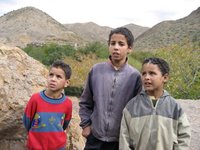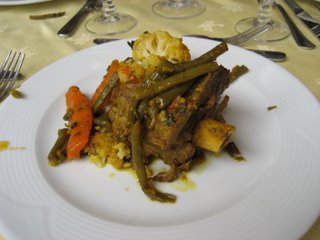Our Sahara Adventure, Part I


 Dear fellow travellers,
Dear fellow travellers, Is this really the Sahara Desert?!?!? Not quite what we were expecting to see!
As it turns out, there has been rain in this region now for several weeks, and we were told that areas of the Sahara have been flooded! It is so bad that we could not drive into the desert on the day we were scheduled to, because the roads were flooded out and the desert was too wet - even the 4x4 trucks were getting stuck!
So, we spent the night in Zagora at another "Salaam" ("Peace) Hotel, ate another meal of chicken tajine, lots of olives, and another breakfast the next morning with lots of bread (French influence) and plenty of Coca cola to calm our stomachs!
We had to put our jackets on because it was so chilly. It rained all night, but we were so excited that we were going to be headed out into the Sahara desert in the morning. We were determined to have this part of our adventure!
The next morning, we loaded up the van and headed east twoards Merzouga, from where we would drive south into the Sahara. We drove all day through towns and past kasbahs and palm orchards.

Here is a map of Morocco.
Can you locate Ouarzazate? Find Zagora and Merzouga.
On a larger map of Morocco, locate Ouarzazate, Zagora and Merzouga.
- What is the longitude and latitude of each town?
- How many kilometers did we travel between each city?
- What is the average rainfall in the Sahara around Merzouga? Was the flood we experienced normal or wacky? Find out and tell us!
We stopped to visit several kasbahs, and to eat lunch, but we had to keep driving becuase it was still raining and our guide didn't know if we would be able to drive into the desert becuase of the flooding. We were driving in a van, and there was a river that was washed out and stranding travelers. Well, by the time we reached this river, it was about 8:00 at night, pitch dark, and the river was a raging flood over the entire roadway. It looked like whitewater rapids! And we said to ourselves, NO WAY! We did not want to get swept away trying to cross that water in a van!
Our van stopped and we sat waiting for what seemed like hours. We were waiting for a 4x4 truck to come pick us up. Well, it finally arrived, we transferred vehicles, and began approaching the river. When we saw the river we really began praying! Our truck stopped behind a line of other vehicles who could not cross the river. There was a line just like it on the other side, waiting to come in our directions. All the vehicles had their headlights shining on the water.We watched another, much larger diesel truck approach the river and slowly drive through. As the truck drove through, the came up to the vehicle doors. We thought for sure it would get stuck, but it kept going, and finally made it to the other side! Well, that's when our driver got adventurous. Our truck pulled out of the line of cars and started moving forward towards the raging rapids flowing across the road. We held our breath (just in case!) and started thinking positive thoughts. Was this really happening? It didn't say anything about whitewater rapid floods in the Sahara in the guidebooks!
Well, we made it through the river, but little did we know that that was only the beginning of the Sahara floodwater adventure.
A short distance later, we turned off the paved road, and headed into the desert. It was pitch black, and a bumpy ride. We did not drive in a straight line, but rather seemed zig zag our way through. We found out the next day that this was because the regular route that the desert drivers used had been washed out and destroyed by the rains, and that our driver was having to negotiate his way around huge puddles and soft spots in the sand.
We thought our driver was doing a pretty good job. Our driver kept assuring us that we were close to our desination, although we could see nothing. Every once in a while, we would see some lights appear then disappear in the distance, and we wondered what they were from. It had stopped raining, and we could see one or two stars in the sky, but not like stars in a planetarium which we had expected to be able to see in the Sahara.
Just as our driver assured us once again that we were almost there, our truck stopped abruptly. The wheels began to spin, and we were STUCK! Our driver made several attempts to get us out, then got on his cell phone and there was a flurry of calls back and forth. We thought how useful cell phones must be in the Sahara - they seemed to get better reception than we get in some places around Boston ("can you hear me now?") - and how this technology must make their lives easier.
Well, after several minutes, out of the darkness came...a bulldozer!!! What? In the middle of the desert?! You just never know what's going to happen out here! The bulldozer was accompanied by 6 or 7 Tuareg men of the desert. They wore blue head wraps and long indigo blue robes, called gandurah. The Tuareg people are known as the warriors, travelers and traders of the desert.
Q: What other information and pictures can you find about the Tuareg people?
The men attached the bulldozer to our truck with some cables, the bulldozer pulled us out, and we started up again, feeling relieved. 50 yards later, we stopped, and this time the truck started sinking. Where was the bulldozer? It had disappeared into the darkness. Well, our driver made a few more calls, the Tuareg men reappeared, and there was some animated discussion. Well, one of the men walked around to the side of the truck and opened the door, and asked us to get out. They told us we would have to walk (were we still going to a tent?!?). It turns out that we were only a few hundred yards from our guesthouse destination, but we didn't know that because it was so dark.
We had to cross a river in the sand, and our guides told us it would be no problem. But, with each step towards the water, our feet sank deeper and deeper into the sand. Alicia and another woman sank up to their knees. The sand was like a suction cup, like quicksand pulling them deeper. Well, the guides helped them out, and we found a much narrower stretch of the water where the sand was also a little firmer, and we could wade through. "Wade in the water, children, wade in the water!" Lucy took her shoes off and experienced her toes in the sand of the Sahara for the first time.
We reached the guest house, and were taken to a room with carpets covering the floor and cushions covering the seats. Hafid, the manager, brought us mint tea to warm us up, and a silver pitcher with hot water, and began washing our feet in the basins. When we protested that he didn't have to do it, he told us that this is a usual ritual. He said that after he and his brothers have been many days in the desert with the camels, his mother welcomes them home and washes and massages their feet with warm water and salt.
They then had a delicious hot meal prepared for us. When we were done eating, the same Tuareg men that had rescued us in the desert brough in their drums and instruments, and began to serenade us with music, singing and dancing.
What a wonderful way to end our long and adventurous day.

But we had to get to bed early, because the camels would be waiting for us at 5 a.m.!
Stay tuned for the next episode of our Adventure int the Sahara!
Love,
Alicia and Lucy



 Berber children we met along our drive through the Tizi 'n' Tichka Pass
Berber children we met along our drive through the Tizi 'n' Tichka Pass
 We had a restful night in the hotel Salaam (Peace hotel), which is modern but has a lot of traditional architectural details and geometrical shapes.
We had a restful night in the hotel Salaam (Peace hotel), which is modern but has a lot of traditional architectural details and geometrical shapes.








